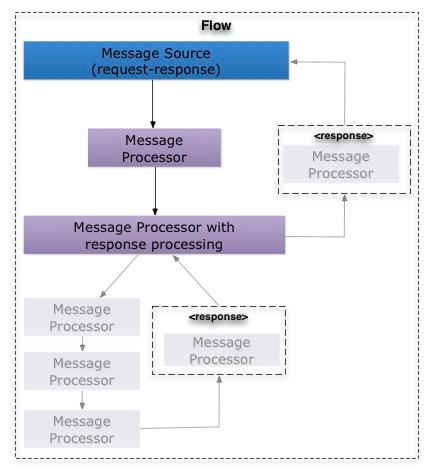
Flows
Introduction
A flow is a simple yet very flexible mechanism that enables orchestration of services using the sophisticated message flow capabilities of Mule. Using a flow, you may automate integration processes and construct Mule message processing solutions by ordering any number of elements of a Mule flow in a valid arrangement. Because what you do inside a flow is up to you as the developer, it is much easier to create solutions that match your requirements.
When to Use a Flow
| A flow is the most versatile and powerful integration mechanism available in Mule. |
Flows are valuable in many situations, including:
-
Simple integration tasks
-
Scheduled data processing
-
Connecting cloud and on-premise applications
-
Event processing where multiple services need to be composed
The Anatomy of a Flow
A flow is in essence just a chain of Message Processors. Think of each Message Processor as a Lego block where a Flow is something you build with them. A flow also has a message source, the source of messages that are processed by the Message Processor chain.

Flow Configuration
A Flow is configured in XML using the <flow> element. Each flow has a name attribute, a message source (unless it’s a private flow), one or more message processors and an optional exception strategy.
Basic Structure
<flow name="">
- 0..1 MessageSource
- 1..n MessageProcessor(s)
- 0..1 ExceptionStrategy
</flow>xmlFlows seem simple, yet can be quite powerful. In particular, when combined with expressions in Mule, they can allow for very sophisticated processing of the message contents. There are many elements that leverage expressions, including:
-
Filters
Example
Simple Book Order Processing Flow
<flow>
<file:inbound-endpoint path="/myDirectory">
<file:filename-filter name="*.xml"/>
</file:inbound-endpoint>
<xml:xslt-transformer xsl-file="bookOrderTransformation.xsl"/>
<splitter expression="xpath://order"/>
<!-- The following message processors will be invoked for each order in the XML file -->
<expression-filter expression="xpath://order[@type='book']"/>
<component class="org.my.BookOrderProcessor"/>
<smtp:outbound-endpoint subject="Order Confirmation" address=""/>
<jdbc:outbound-endpoint />
<default-exception-strategy>
<jms:outbound-endpoint queue="failedOrders"/>
</default-exception-strategy>
</flow>xmlFlow Behavior
When the message source receives or generates a message, the source starts the flow by calling the configured message processors in a chain that executes in the same order as they are configured. Some message processors accept child message processor elements. In this case these are processed before returning and continuing processing the main list. This is the behavior when the flow is one-way.
If the flow is request-response, because it contains an inbound endpoint defined as a request-response exchange pattern, then the result of the flow execution is returned to the inbound endpoint and then in turn to the caller. If there are no <response> blocks in your flow and if none of the configured message processors perform any response processing, then the response is the result from the last Message Processor in the flow. If a <response> block is configured, then the message processors configured in this element process the response message. Some message processors, such as CXF, process the response message as part of their default configuration.
Note: When the last element in the flow configuration is a one-way <outbound-endpoint> there’s no result after its execution, so the returned payload of the message is NullPayload. If the one-way <outbound-endpoint> is followed by another processor, this processor receives as input the same message that the <outbound-endpoint> receives, instead of NullPayload.

Private Flows
A private flow is one that cannot be accessed from outside the JVM via a Mule Endpoint because it has no message source defined.
Private Flows are therefore only used if they are referenced from another construct running in the same Mule instance. When configuring Mule using XML the <flow-ref> element is used to include one flow in another.
A private Flow differs from the use of a "Processor Chain" in that a Flow has it’s own context and exception strategy where as when a processor chain is referenced, it is executed in the context of the flow that references it.
Private Flow Example
<flow name="privateFlow">
<append-string-transformer message="b"/>
</flow>
<flow name="publicFlow">
<http:inbound-endpoint address="http://localhost:8080"/>
<append-string-transformer message="a"/>
<flow-ref name="privateFlow"/>
<append-string-transformer message="c"/>
</flow>xml


